The following is a draft letter to UK Prime Minister Gordon Brown, on the subject of proposed new coal-fired power plants. (A similar letter is in the works to German Chancellor Angela Merkel.) The author would appreciate feedback.
—–
Dear Prime Minister Brown,
Your leadership is needed on a matter concerning coal-fired power plants in your country, a matter with global ramifications, as I will clarify.
For the sake of identification, I am a United States citizen, director of the NASA Goddard Institute for Space Studies and Adjunct Professor at the Columbia University Earth Institute. I write, however, as a private citizen, a resident of Kintnersville, Pennsylvania, on behalf of the planet and life on Earth, including all species.
I recognize that you strongly support policies aimed at reducing the danger of global warming. Also Great Britain has been a leader in pressing for appropriate international actions.
Yet there are plans for construction of new coal-fired power plants in Great Britain. Consummation of those plans would contribute to foreseeable adverse consequences of global warming. Conversely, a choice not to build could be a tipping point that seeds a transition that is needed to solve the global warming problem.
Basic Fossil Fuel Facts
The role of coal in global warming is clarified by a small number of well-documented facts. Figure 1 shows the fraction of fossil fuel carbon dioxide (CO2) emissions that remains in the air over time. One-third of the CO2 is still in the air after 100 years, and one-fifth is still in the air after 1000 years.
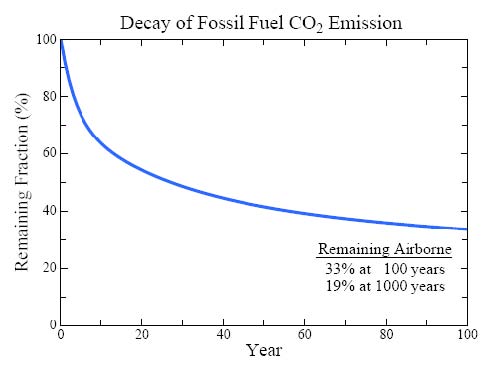
Figure 1. Decay of a pulse of CO2 added to the atmosphere by burning fossil fuels.
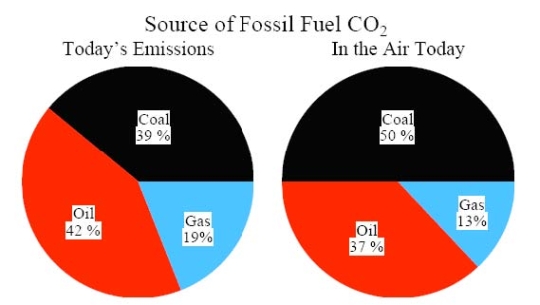
Figure 2. Percent contributions of different fossil fuels to 2006 CO2 emissions (left side) and contributions to the excess CO2 in the air today relative to pre-industrial CO2 amount.
Oil slightly exceeds coal as a source of CO2 emissions today, as shown in Figure 2 (left side). But, because of the long atmospheric lifetime of past emissions, fully half of the excess CO2 in the air today (from fossil fuels), relative to pre-industrial times, is from coal (right side of Figure 2). Moreover, coal use is now increasing, while oil production has stagnated. Oil production will peak and will be constrained by available resources earlier than will coal production.

Figure 3. Estimated fossil fuel reserves (purple portions have already been used).
Figure 3 shows reported fossil fuel reserves and resources (estimated undiscovered deposits). Reserves are hotly debated and may be exaggerated, but we know that enough oil and gas remain to take global warming close to, if not into, the realm of dangerous climate effects. Coal and unconventional fossil fuels such as tar shale contain enough carbon to produce a vastly different planet than the one on which civilization developed, a planet without Arctic sea ice, with crumbling ice sheets that assure sea level catastrophes for our children and grandchildren, with shifting climate zones that drive countless species to extinction, and with intensified hydrologic extremes that cause increased drought and wildfires but also stronger rain, floods, and storms.
Oil and coal uses differ fundamentally. Oil is burned primarily in small sources, in vehicles where it is impractical to capture the CO2 emissions. Available oil reserves will be exploited eventually, regardless of efficiency standards on vehicles, and the CO2 will be emitted to the atmosphere. The climate effect of oil is nearly independent of how fast we burn the oil, because much of the CO2 remains in the air for centuries. [It is nevertheless important to improve efficiency of oil use, because that buys us time to develop technologies and fuels for the post-oil era, and high efficiency surely will be needed in the post-oil era.] However, the point is this: oil will not determine future climate change. Coal will.
Avoiding dangerous atmospheric CO2 levels requires curtailment of CO2 emissions from coal. Atmospheric CO2 can be stabilized by phasing out coal use except where the CO2 is captured and sequestered, as is feasible at power plants. Indeed, agreement to phase out coal use except where the CO2 is captured is 80% of the solution to the global warming crisis. Of course, it is a tall order, as coal is now the world’s largest source of electrical energy. Over the next few decades those coal plants must be closed or made to capture their CO2 emissions. Yet it is a doable task. Compare that task, for example, with the efforts and sacrifices that went into World War II.
Responsibility for Global Warming
Responsibility for global warming is proportional to cumulative CO2 emissions, not to current emission rates (PDF). This is a consequence of the long lifetime of atmospheric CO2. Responsibility of the United States is more than three times larger than that of any other nation (Figure 4). Despite rapid growth of emissions from China, the United States will continue to be the nation most responsible for climate change for at least the next few decades.
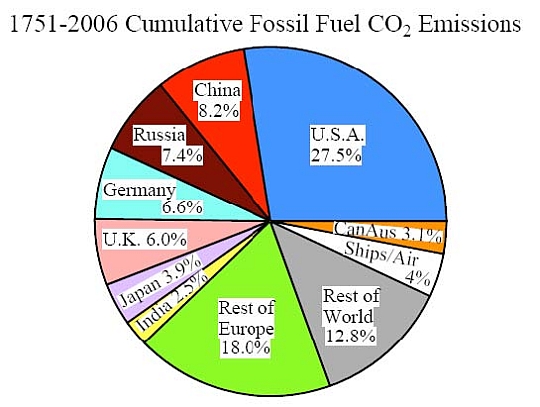
Figure 4. Cumulative fossil fuel CO2 emissions through 2006 by country of emission.
It is also useful to examine per capita fossil fuel CO2 emissions. Figure 5 shows per capita emissions for the eight nations with largest total emissions, in order of decreasing total emissions. The United States and Canada have the largest per capita emissions, while emissions of Japan, Germany and the United Kingdom are half as large per capita.
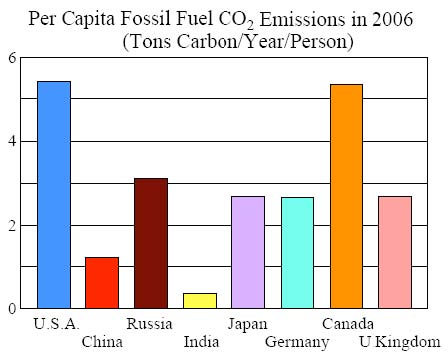
Figure 5. Per capita fossil fuel emissions today in order of national total emissions.
Per capita responsibility for climate change, however, must be based on cumulative national emissions. The United Kingdom has the highest per capita responsibility, as shown in Figure 6. The United States is second most responsible and Germany is third. Increased responsibility of the United Kingdom and Germany is a consequence of their early entries into the industrial era. Recognition of these facts is not an attempt to cast blame. Early emissions of CO2 occurred before the climate problem was recognized and well before it was proven. Yet these facts are worth bearing in mind.

Figure 6. Per capita cumulative 1751-2006 fossil fuel CO2 emissions.
Human-made climate change is unambiguously underway. Yet the urgency of the situation is not readily apparent to everybody. Chaotic weather fluctuations mask climate trends, even as climate change alters the nature of weather. Urgency is created by the very inertia of the climate system that delays the effects of gases already added to the air. This delay means that there is additional global warming “in the pipeline” due to human-produced gases already in the air.
Climate system inertia is due in part to the massive oceans, four kilometers deep on average, which are slow to warm in response to increasing greenhouse gases. The effect of this inertia is compounded by positive (amplifying) feedbacks, such as melting of ice and snow, which increases absorption of sunlight, engendering more melting. Such feedbacks are not “runaway” processes, but they make climate sensitive to moderate forcings, both natural and human-made forcings, such as increasing atmospheric greenhouse gases.
Climate inertia and positive feedbacks together create the danger of passing climate “tipping points”. A tipping point exists when the climate reaches a point such that little if any additional forcing is needed to instigate large, relatively rapid climate change and impacts. Impacts of these large climate changes tend to be, overall, detrimental to humans and other species, because life is adapted to the relatively stable interglacial period that has existed on our planet for about ten thousand years.
Based on current information, we now realize that we have passed or are on the verge of passing several tipping points that pose grave risks for humanity and especially for a large fraction of our fellow species on the planet. This information is gleaned primarily from the Earth’s history and ongoing global observations of rapid climate changes, and to a lesser extent from climate models that help us interpret observed changes.
Potential consequences of passing these tipping points include (1) loss of warm season sea ice in the Arctic and thus increased stress on many polar species, possibly leading to extinctions, (2) increasing rates of disintegration of the West Antarctic and Greenland ice sheets, and thus more rapidly rising sea levels in coming decades, (3) expansion of sub-tropical climates adversely affecting water availability and human livability in regions such as the American West, the Mediterranean, and large areas in Africa and Australia, (4) reduction of alpine snowpack and water run-off that provides fresh water supplies for hundreds of millions of people in many regions around the world, and (5) increased intensity of the extremes of the hydrologic cycle, including more intense droughts and forest fires, on the one hand, but also heavier rains and greater floods, as well as stronger storms driven by latent heat, including tropical storms, tornados and thunderstorms.
The nearness of these climate tipping points is no cause for despair. On the contrary, the actions that are needed to avert the tipping point problems are not only feasible, they have side benefits that point to a brighter future for life on the planet, with cleaner air and cleaner water. It will be necessary to roll back the airborne amounts of some pollutants, but that is plausible, given appropriate attention. Already all pollutants except CO2 are falling at or below the lowest IPCC (Intergovernmental Panel on Climate Change) scenarios, and there is much potential for further reductions.
The tendency of the media to continually report bad news on climate change and the human-made factors that drive climate change sometimes paints a picture that is bleaker than that shown by careful analysis. Such information is often misleading about the true status of the Earth, and the impression created may be harmful if it leads to despair about the prospects for achieving a relatively stable climate with a cleaner atmosphere and ocean. I illustrate with data for CO2, the most important climate forcing.
Figure 7 is the “airborne fraction” of fossil fuel CO2 emissions. This is the ratio: the annual increase of CO2 that appears in the Earth’s atmosphere (well measured) divided by the annual human emission of fossil fuel CO2 into the air (also well known). On average, the increase of CO2 in the air is only 57% of the amount emitted in burning of fossil fuels. This is despite the fact that humans are also causing extensive, mostly unwise, deforestation, which adds CO2 to the air. In addition our agricultural practices typically do not encourage storage of carbon in the soil.
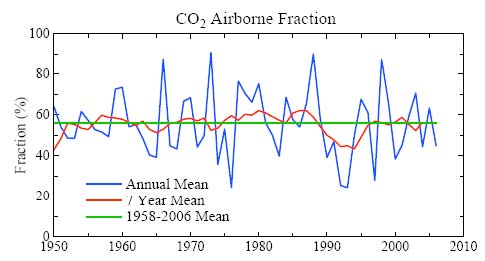
Figure 7. Ratio of observed atmospheric CO2 increase to fossil fuel CO2 emissions.
There is tremendous potential for reducing atmospheric CO2 via reduction of deforestation, improved forestry practices, and improved agricultural practices that increase carbon storage in the soil. If governments were to encourage such practices, rather than the converse, and if coal use were phased out except where the CO2 is captured, it would be possible to literally roll back the net human-made climate forcing to levels below those defining critical tipping points.
We must remember, at the same time, that the ability of the principal CO2 sink, the ocean, to soak up human-made emissions is limited and slow (Figure 1). If we burn most of the available coal (Figure 3) without CO2 capture, even with the lowest estimates of available coal reserves, it will be impractical if not impossible to avoid passing climate tipping points with disastrous consequences.
I am optimistic that we can reduce greenhouse gas emissions and stabilize atmospheric composition at a level avoiding disastrous climate effects. My optimism is based in part on the fact that young people are beginning to make their voices heard. They have a powerful effect on our consciences, with an ability to influence policy makers and the captains of industry.
Many individuals are beginning to recognize and appreciate the nature of the climate problem. People want to take actions and they are willing to make sacrifices. However, individual actions cannot solve the problem by themselves.
Based on fossil fuel and carbon cycle facts summarized above, we cannot continue to burn the coal reserves without CO2 capture and sequestration. Solution of this problem can be achieved only via strong government leadership.
Governments must recognize the relative magnitudes of fossil fuel resources, i.e., oil, gas, coal, and unconventional fossil fuels, and they must establish policies that influence consumption in ways consistent with preservation of our climate and life on Earth. The fossil fuel facts dictate essential actions (PDF):
- Phase-out of coal use that does not capture CO2. This is 80% of the solution, creating a situation in which CO2 emissions are declining sharply. (Coal use will also be affected by the second essential action. Indeed, it is likely that much of the coal will be left in the ground, as incentives spark innovations and positive feedbacks, accelerating progress to the cleaner world beyond fossil fuels.)
- A gradually but continually rising price on carbon emissions. This will assure that, as oil production inevitably declines, humanity does not behave as a desperate addict, seeking every last drop of oil in the most extreme pristine environments and squeezing oil from tar shale, coal, and other high-carbon sources that would assure destruction of our climate and most species on the planet. Recognition by industry of a continually rising carbon price (and elimination of fossil fuel subsidies) would drive innovations in energy efficiency, renewable energies, and other energy sources that do not produce greenhouse gases.
These are the two fundamental actions that must occur if we are to roll back the net climate forcing and avoid the dangerous climate tipping points, with their foreseeable consequences. Both of these actions are essential.
We can make a long list of supplementary actions that will be needed to avoid hardships and minimize dislocations as we phase into a cleaner world beyond fossil fuels. However, the two essential actions must be given priority and governments must explain the situation to the public.
Supplementary actions include improved efficiency standards on buildings, vehicles, appliances, etc. Rules must be changed so that utilities profit by encouraging efficiency, rather than selling more energy. But governments must recognize these actions as being supplementary to the essential actions dictated by the physics of the carbon cycle, specifically the requirement to constrain release of CO2 to the air from the large carbon reservoirs.
Further actions will be needed to achieve a rollback of the net climate forcing. These actions (PDF) include reduction of non-CO2 climate forcings and improved agricultural and forestry practices. These actions are important and have multiple benefits, especially in developing countries, but they do not have the great urgency of halting construction of new coal plants without carbon capture. Power plants have long lifetimes, and once their CO2 is released to the air, it is impractical to recover it.
Energy departments, influenced by fossil fuel interests, take it as a God-given fact that we will extract all fossil fuels from the ground and burn them before we move on to other ways of producing usable energy. The public is capable of changing this course dictated by fossil fuel interests, but clear-sighted leadership is needed now if the actions are to be achieved in time.
Tipping points and positive feedbacks exist among people, as well as in the climate system. I believe that the action with the greatest potential to initiate positive feedbacks, and lead to the benefits that will accompany a clean energy future, is a moratorium in the West on new coal-fired power plants unless and until CO2 capture and sequestration technology is available. Such a moratorium would provide the West with sufficient moral authority to sit down with China and other developing countries to find ways, likely including technological assistance, for developing countries to also phase out coal use that does not capture CO2.
As shown above, responsibility for the first step rests with Great Britain, the United States and Germany. Despite lack of government leadership, citizens in the United States are stepping up to block one coal plant after another, and the next national election is less than a year away.
If Great Britain and Germany halted construction of coal-fired power plants that do not capture and sequester the CO2, it could be a tipping point for the world. There is still time to find that tipping point, but just barely. I hope that you will give these considerations your attention in setting your national policies. You have the potential to influence the future of the planet.
Prime Minister Brown, we cannot avert our eyes from the basic fossil fuel facts, or the consequences for life on our planet of ignoring these fossil fuel facts. If we continue to build coal-fired power plants without carbon capture, we will lock in future climate disasters associated with passing climate tipping points. We must solve the coal problem now.
For your information, I am sending a similar letter to Chancellor Merkel.
Godspeed,
James E. Hansen
Kintnersville, Pennsylvania
United States of America

